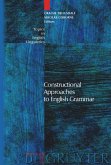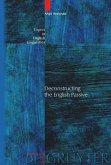Taking as its point of departure the general assumption that meaning is crucial in accounting for verb complementation, this volume presents the results of an empirical study of verb complementation patterns of semantically similar English verbs. The semantic parallels of the verbs selected are based on their coverage in dictionaries - first and foremost the Valency Dictionary of English (Herbst, Heath, Roe and Götz 2004) - as well as corpus research and native speaker assessments. It is demonstrated that despite obvious similarities in complementation between such verbs, there are still a significant number of syntactic discrepancies which cannot be accounted for on the basis of meaning alone and that semantic factors - such as selection restrictions and aspectual properties - do not sufficiently correlate with the verbs' syntactic properties and consequently do not have sufficient explanatory power.
Thus the results rigorously challenge so-called projectionist approaches which assume the position that complementation is determined by semantic properties and thus ought to be predictable on this basis. In the light of a general trend towards placing greater emphasis on semantic aspects, in the fields of construction grammar and cognitive grammar too, the number of idiosyncratic phenomena on the level of single complements as well as whole patterns clearly underlines the importance of storage phenomena as opposed to rule-based generation. As such it stresses the necessity of finding ways to systematically account for item-specific properties of verbs in any grammatical theory of the English language.
The book is targeted at all linguists interested in the relationship between semantics and syntax, which is one of the prevalent questions in modern linguistics, also in the field of construction grammar and cognitive grammar. Since the data is presented in a way which is compatible with various theories of complementation, the target group is clearly not restricted to any specific linguistic school. Because of the large amount of item-specific information presented, this book is also a valuable source for grammarians and lexicographers.
Thus the results rigorously challenge so-called projectionist approaches which assume the position that complementation is determined by semantic properties and thus ought to be predictable on this basis. In the light of a general trend towards placing greater emphasis on semantic aspects, in the fields of construction grammar and cognitive grammar too, the number of idiosyncratic phenomena on the level of single complements as well as whole patterns clearly underlines the importance of storage phenomena as opposed to rule-based generation. As such it stresses the necessity of finding ways to systematically account for item-specific properties of verbs in any grammatical theory of the English language.
The book is targeted at all linguists interested in the relationship between semantics and syntax, which is one of the prevalent questions in modern linguistics, also in the field of construction grammar and cognitive grammar. Since the data is presented in a way which is compatible with various theories of complementation, the target group is clearly not restricted to any specific linguistic school. Because of the large amount of item-specific information presented, this book is also a valuable source for grammarians and lexicographers.








